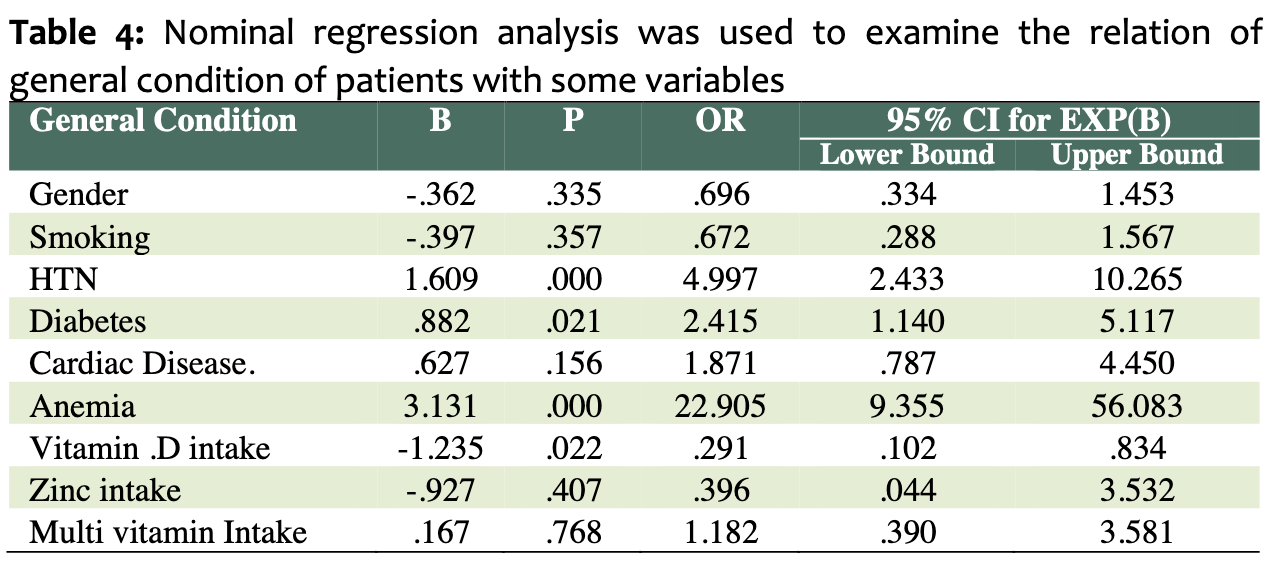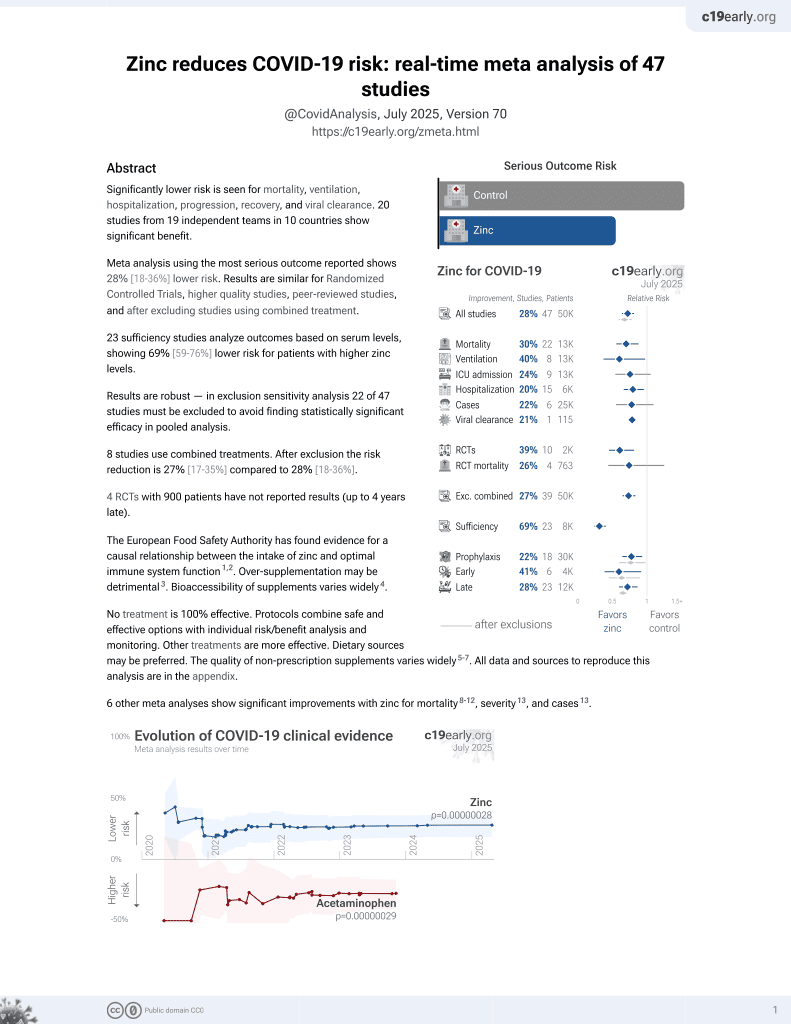
Supplement Usage Pattern in a Group of COVID-19 Patients in Tehran
et al., Journal of Family & Reproductive Health, doi:10.18502/jfrh.v14i3.4668 , Sep 2021
Zinc for COVID-19
2nd treatment shown to reduce risk in
July 2020, now with p = 0.00000028 from 47 studies, recognized in 23 countries.
No treatment is 100% effective. Protocols
combine treatments.
6,300+ studies for
210+ treatments. c19early.org
|
Retrospective 510 patients in Iran, showing lower risk of severity with vitamin D (statistically significant) and zinc (not statistically significant) supplementation. IR.TUMS.VCR.REC.1398.1063.
Study covers zinc and vitamin D.
|
risk of severe case, 60.4% lower, OR 0.40, p = 0.41, treatment 33, control 477, adjusted per study, multinomial logistic regression, RR approximated with OR.
|
|
risk of hospitalization, 41.0% lower, RR 0.59, p = 0.37, treatment 4 of 33 (12.1%), control 167 of 477 (35.0%), NNT 4.4, adjusted per study, inverted to make RR<1 favor treatment, odds ratio converted to relative risk, binary logistic regression.
|
| Effect extraction follows pre-specified rules prioritizing more serious outcomes. Submit updates |
Bagheri et al., 1 Sep 2021, retrospective, Iran, peer-reviewed, 6 authors.
Supplement Usage Pattern in a Group of COVID-19 Patients in Tehran
Objective: The coronavirus disease 19 (COVID-19) is a highly transmittable and pathogenic viral infection, causes severe acute respiratory syndrome and was spread throughout the world in early 2020. The effects of vitamin and micronutrient supplements on the prevention and treatment of COVID-19 seems challenging in scientific considerations. On the other side generally, experts warn against overconsumption of these supplements. Materials and methods: This study aimed to investigate the vitamin and micronutrient supplementation usage pattern in past history of patients with COVID-19 via a cross-sectional inquiry. Totally 510 patients referring to the infectious disease clinic of Imam Khomeini Hospital in Tehran from March 2020 to May 2020 were recruited. The inclusion criterion was suspected patients for COVID-19 based on clinical findings and CT scans of the lung. The infected patients included both inpatients (171) and outpatients (339). Demographic information, clinical signs, and the supplement pattern use were collected through a questionnaire and the data were statistically analyzed. Results: Vitamin D3 intake was reported in 30% (103 patients) of outpatients and 16.5% (28 patients) of hospitalized patients, which is statistically significant (P=0.001). It shows that, the frequency of vitamin D3 consumption in the outpatient group was higher than inpatient group. This significant difference has also been shown in zinc consumption, in 29 patients (9%) outpatients versus 4 patients (2%) inpatients were reported (P=0.007). Multi nominal regression showed that vitamin D3 intake has a supportive effect and reduces the risk of exacerbation and worsening of the disease. (OR=0.291; 95% CI 0.102-.0834, P=0.022). Conclusion: According to the results of the present study and the findings of other studies, considering the supportive effect of vitamin D3 in reducing the severity of infectious diseases; Clinical trials with an appropriate sample size are recommended to investigate the functional role of this vitamin in improving viral diseases of the respiratory tract.
References
Annweiler, COVID-19 and Vitamin D Supplementation: a Multicenter Randomized Controlled Trial of High Dose Versus Standard Dose Vitamin D3 in High-risk COVID-19 Patients
Bagheri, Haghollahi, Shariat, Jafarabadi, Aryamloo et al., Supplement Usage Pattern in a Group of COVID-19 Patients in Tehran, J Fam Reprod Health
Bartley, Vitamin D, innate immunity and upper respiratory tract infection, J Laryngol Otol
Beard, Bearden, Striker, Vitamin D and the anti-viral state, J Clin Virol
Bergman, Lindh, Björkhem-Bergman, Lindh, Vitamin D and Respiratory Tract Infections: A Systematic Review and Meta-Analysis of Randomized Controlled Trials, PLoS One
Calder, Carr, Gombart, Eggersdorfer, Optimal Nutritional Status for a Well-Functioning Immune System Is an Important Factor to Protect against Viral Infections, Nutrients
Elmadfa, Meyer, The Role of the Status of Selected Micronutrients in Shaping the Immune Function, Endocr Metab Immune Disord Drug Targets
Gombart, Pierre, Maggini, A Review of Micronutrients and the Immune System-Working in Harmony to Reduce the Risk of Infection, Nutrients
Grant, Lahore, Mcdonnell, Baggerly, French et al., Evidence that Vitamin D Supplementation Could Reduce Risk of Influenza and COVID-19 Infections and Deaths, Nutrients
Grober, Kisters, Influence of drugs on vitamin D and calcium metabolism, Dermatoendocrinol
Huang, Caballero, Chang, Alberg, Semba et al., The Efficacy and Safety of Multivitamin and Mineral Supplement Use To Prevent Cancer and Chronic Disease in Adults: A Systematic Review for National Institutes of Health State-of-the-Science Conference, Ann Intern Med
Laaksi, Vitamin D and respiratory infection in adults, Proc Nutr Soc
Lee, Hecke, Roberts, Vitamin D: A rapid review of the evidence for treatment or prevention in COVID-19. CEBM, The Centre for Evidence-Based Medicine develops, promotes and disseminates better evidence for healthcare
Li, Geng, Peng, Meng, Sh, Molecular immune pathogenesis and diagnosis of COVID-19, J Pharm Anal
Li, Zh, Wang, Zhou, Qiu et al., The epidemic of 2019-novel-coronavirus (2019-nCoV) pneumonia and insights for emerging infectious diseases in the future, Microbes Infect
Maclaughlin, Holick, Aging decreases the capacity of human skin to produce vitamin D3, J Clin Invest
Martineau, Jollie, Hooper, Vitamin D supplementation to prevent acute respiratorytract infections: Systematic review and meta-analysis of individual participant data, BMJ
Rautiainen, Manson, Lichtenstein, Sesso, Dietary supplements and disease prevention -a global overview, Nat Rev Endocrinology
Read, Obeid, Ch, Ahlenstiel, The Role of Zinc in Antiviral Immunity, Adv Nutr
Shereen, Khan, Kazmi, Bashir, Siddigue, COVID-19 infection: Origin, transmission, and characteristics of human coronaviruses, J Adv Res
Skalny, Rink, Ajsuvakova, Aschner, Gritsenko et al., Zinc and respiratory tract infections: Perspectives for COVID-19 (Review), Int J Mol Med
Tu, Sh, Gao, Shao, Sheng, Current epidemiological and clinical features of COVID-19 ; a global perspective from China, J Infect
Vasarhelyi, Satori, Olajos, Szabo, Beko, Low vitamin D levels among patients at Semmelweis University: Retrospective analysis during a one-year period, Orv Hetil
Velthuis, Van Den Worm, She, Sims, Baric et al., Zn2+ inhibits coronavirus and arterivirus RNA polymerase activity in vitro and zinc ionophores block the replication of these viruses in cell culture, PLoS Pathog
Wimalawansa, Global epidemic of coronavirus-COVID-19 : What we can do to minimze risks, Eur J Biomed Pharm Sci
DOI record:
{
"DOI": "10.18502/jfrh.v14i3.4668",
"ISSN": [
"1735-9392",
"1735-8949"
],
"URL": "http://dx.doi.org/10.18502/jfrh.v14i3.4668",
"abstract": "<jats:p>Objective: The coronavirus disease 19 (COVID-19) is a highly transmittable and pathogenic viral infection, causes severe acute respiratory syndrome and was spread throughout the world in early 2020. The effects of vitamin and micronutrient supplements on the prevention and treatment of COVID- 19 seems challenging in scientific considerations. On the other side generally, experts warn against over-consumption of these supplements.
\nMaterials and methods: This study aimed to investigate the vitamin and micronutrient supplementation usage pattern in past history of patients with COVID-19 via a cross-sectional inquiry. Totally 510 patients referring to the infectious disease clinic of Imam Khomeini Hospital in Tehran from March 2020 to May 2020 were recruited. The inclusion criterion was suspected patients for COVID-19 based on clinical findings and CT scans of the lung. The infected patients included both inpatients (171) and outpatients (339). Demographic information, clinical signs, and the supplement pattern use were collected through a questionnaire and the data were statistically analyzed.
\nResults: Vitamin D3 intake was reported in 30% (103 patients) of outpatients and 16.5% (28 patients) of hospitalized patients, which is statistically significant (P=0.001). It shows that, the frequency of vitamin D3 consumption in the outpatient group was higher than inpatient group. This significant difference has also been shown in zinc consumption, in 29 patients (9%) outpatients versus 4 patients (2%) inpatients were reported (P=0.007). Multi nominal regression showed that vitamin D3 intake has a supportive effect and reduces the risk of exacerbation and worsening of the disease. (OR=0.291; 95% CI 0.102-.0834, P=0.022).
\nConclusion: According to the results of the present study and the findings of other studies, considering the supportive effect of vitamin D3 in reducing the severity of infectious diseases; Clinical trials with an appropriate sample size are recommended to investigate the functional role of this vitamin in improving viral diseases of the respiratory tract.</jats:p>",
"author": [
{
"affiliation": [],
"family": "Bagheri",
"given": "Maryam",
"sequence": "first"
},
{
"affiliation": [],
"family": "Haghollahi",
"given": "Fedyeh",
"sequence": "additional"
},
{
"affiliation": [],
"family": "Shariat",
"given": "Mamak",
"sequence": "additional"
},
{
"affiliation": [],
"family": "Jafarabadi",
"given": "Mina",
"sequence": "additional"
},
{
"affiliation": [],
"family": "Aryamloo",
"given": "Parastoo",
"sequence": "additional"
},
{
"affiliation": [],
"family": "Rezayof",
"given": "Elahe",
"sequence": "additional"
}
],
"container-title": "Journal of Family & Reproductive Health",
"container-title-short": "JFRH",
"content-domain": {
"crossmark-restriction": false,
"domain": []
},
"created": {
"date-parts": [
[
2020,
11,
18
]
],
"date-time": "2020-11-18T10:25:48Z",
"timestamp": 1605695148000
},
"deposited": {
"date-parts": [
[
2022,
2,
14
]
],
"date-time": "2022-02-14T11:26:51Z",
"timestamp": 1644838011000
},
"indexed": {
"date-parts": [
[
2024,
2,
15
]
],
"date-time": "2024-02-15T09:25:02Z",
"timestamp": 1707989102302
},
"is-referenced-by-count": 5,
"issued": {
"date-parts": [
[
2020,
11,
18
]
]
},
"link": [
{
"URL": "https://publish.kne-publishing.com/index.php/JFRH/article/download/4668/4252",
"content-type": "application/pdf",
"content-version": "vor",
"intended-application": "text-mining"
},
{
"URL": "https://publish.kne-publishing.com/index.php/JFRH/article/download/4668/4252",
"content-type": "unspecified",
"content-version": "vor",
"intended-application": "similarity-checking"
}
],
"member": "7770",
"original-title": [],
"prefix": "10.18502",
"published": {
"date-parts": [
[
2020,
11,
18
]
]
},
"published-online": {
"date-parts": [
[
2020,
11,
18
]
]
},
"publisher": "Knowledge E",
"reference-count": 0,
"references-count": 0,
"relation": {},
"resource": {
"primary": {
"URL": "https://publish.kne-publishing.com/index.php/JFRH/article/view/4668"
},
"secondary": [
{
"URL": "https://jfrh.tums.ac.ir/index.php/jfrh/article/view/1501"
},
{
"URL": "https://publish.kne-publishing.com/index.php/JFRH/article/view/4668"
}
]
},
"score": 1,
"short-title": [],
"source": "Crossref",
"subject": [
"Family Practice",
"Obstetrics and Gynecology",
"Reproductive Medicine"
],
"subtitle": [],
"title": "Supplement Usage Pattern in a Group of COVID- 19 Patients in Tehran",
"type": "journal-article"
}
bagheri
